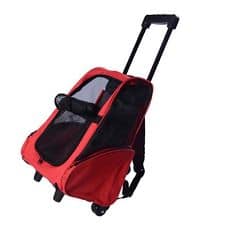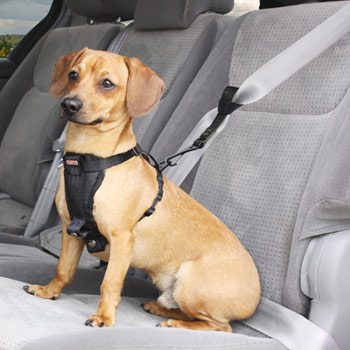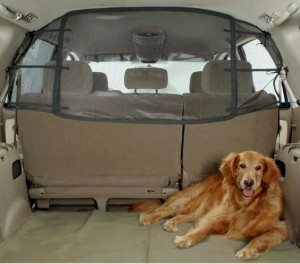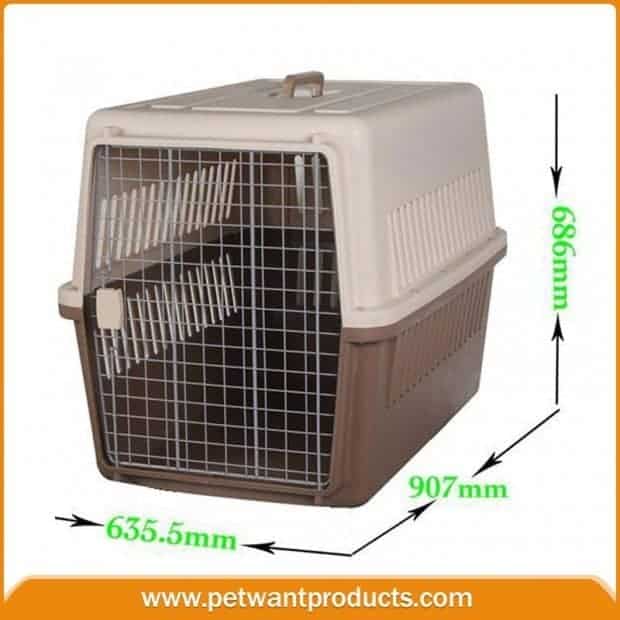When travelling with your dog in the car, as pet owners their safety is our responsibility. Car restraints come in many shapes and sizes and there is little regulation in the industry to ensure safety.
Travelling with pets means ensuring their safety as well as ours. In many areas it is a legal requirement to have your pet safely restrained while travelling, but the definition of restrained can be fairly flexible. The important part is to ensure that your pet can’t interfere with your ability to drive (so perhaps having them on your lap is not a great idea!), and that if you stop, they won’t fall or end up injuring themselves.
The types of car restraints fall into several categories and it does depend on the temperament and size of your canine travel buddy. Smaller dogs who love to watch out through the window may need an elevated seat. Larger dogs my need a mesh guard to keep them confined in the back. If your pet gets sick in the car, sometimes blocking off their ability to see out the side windows can help with nausea, so that things aren’t zipping by quite so fast.
Transport carriers
For anxious pets, smaller dogs or those that are likely to soil your vehicle a transport crate is a great option. They can be set up like a ‘den’, with a comfortable bed and should be big enough for your dog to turn around, stand and stretch. They are often used for airline travel and are quite sturdy and well-ventilated.
Before crating your pet, first get him accustomed to spending time in there by putting a bed in there, feeding him and giving him treats in there and leaving the door open for him to explore. In time many pets will develop a very happy association with their crate and it can then be closed in without undue stress. When travelling, just make sure you let your pet out every couple of hours for exercise and toilet breaks. For easy storage there are also soft-sided collapsible crates and if your pet is heavy you can use a luggage trolley to transport them and some are on wheels anyway.

Just be aware before considering where you place the crate that many cars have ‘crumple zones’ that are designed to absorb impact should you have a serious collision. The front and boot of a car are typical crumple zones, so putting your pet in the boot is often a very bad idea for this reason. It may also seem like a brilliant idea to place a seatbelt around a smaller carrier to stabilize it, but according to the Center For Pet Safety, this can actually be a problem in an accident if the carrier is not sturdy enough. For a smaller carrier, placing it on the floor behind the front seat is the safest place.
Seatbelts and harnesses

For a larger dog who is happy sitting upright on the back seat of your car (or perhaps shot-gun in the front), using a harness with selt-belt attachment is a great option. Ideally a harness is safer in the event of an accident than a collar, as it more evenly distributes the force should you need to brake suddenly.
There are a few designs, either with a loop that sits over the shoulders that allows you to place the selt-belt through, or a style that has a separate clip that directly plugs in, instead of the regular selt-belt. Just be aware that if the harness allows a fair bit of movement it is most likely also going to result in some serious whiplash for your dog, should you have to brake suddenly. Your dog can end up turning into a projectile and injuring other passengers and himself. For some scary slow-motion videos of what can happen during a crash, check this out.
There is no real safety regulation in the pet industry, so there are many unsupported claims when it comes to safety for travel harnesses. In the above video many harnesses simply broke at the weakest point and did not protect anyone. The clips, straps and anchor points are often very flimsy and many allow significant movement should you need to brake suddenly or you are re-ended.
They may stop your pet roaming around in the vehicle, but they may not hold up in an accident. Even if the product says it is safety tested, because the pet industry is self-regulated, there is no independent body that makes companies accountable for their claims.
Some safety harnesses can also easily be unclipped if your dog steps on the release mechanism by accident and from there your dog is free to roam. If your window mechanism is easy to set you’re your pet could then even open the window. Murphy’s law states that of course this would only happen when you are on the highway travelling at 110kms an hour!
In the Center for Pet Safety test the only truly secure harness was theClickit by Sleepypod. It is worth checking out how this product performs compared to the competition. This particular device allows attachment at 3 points and utilises those hooks at the base of the seat used to attach kid’s car seats (most modern cars have these now).
Barriers

If your dog is larger and you have a sedan or 4WD, having a barrier to keep your pet secure in the back can be an excellent option. This means they have plenty of room to move on longer trips, but can’t end up being a projectile should you need to brake suddenly. There are many types of barriers, some temporary, some more permanent.
Just make sure they comply with RTA standards and are securely affixed. This option allows for great movement, but does little to protect your pet in the case of an accident. The boot is usually the crumple zone of the car and should you have an accident your pet will become a projectile. Even with a small accident, should the back door open, your pet can then escape onto the road.
Booster Seats
Booster seats allow smaller pets to sit a little higher. They also look adorable. There are some safety concerns with these seats both for human travellers and pets. They place dogs at head height, meaning the dog can become a projectile should the car be in an accident. If you do use them, make sure you also use an additional car-safe harness that will keep your dog safely anchored.
Truck safety
If your dog regularly travels out in the open in a truck, restraint is even more important. Vets regularly see dogs that have fallen from the back of a truck and been dragged, hit by the car behind or suffered injuries from the fall.
Ensure that any rope or chain is short, so should your dog fall he won’t hang. Also make sure there is appropriate protection from the elements, such as sun protection. You should also ensure there are no other objects back there that could squash your dog when moving around.
Front seat travel
Travelling in the front seat can be a little dangerous unless your pet is crated, mainly due to airbags, so as with our children, put your furry kids in the back seat where they are safer. If you must have your pet in the front, use a harness that keeps them firmly anchored like the Clickit.
Nervous travellers
If your pet is nervous in the car, put a little time into training them to become accustomed to travel. In many cases a pet has had a somewhat bad time when in the car, for example feeling nauseous as a puppy on that trip to the vet. The first step is to use lots of treats, take your pet to the car and feed him some tasty treats in the car. Don’t go anywhere until this step has been achieved with no signs of anxiety from your dog.
Once your pet is okay with this stage, take a short trip down the driveway, then come back. Gradually increase the length of the trips, always keeping the training positive and stopping before your pet shows signs of distress. Alternatively, ask your vet for some tablets for nausea and avoid feeding your pet in the morning before a car trip.
We hope the above guide has helped you make an informed and safe choice for your pet when travelling in the car. Travelling in the car is often one of the great pleasures in life for dogs, particularly if those trips end up somewhere fun.



![dog-in-car[1] dog in car](https://www.vetbabble.com/wp-content/uploads/2021/03/dog-in-car1-696x299.jpg)






